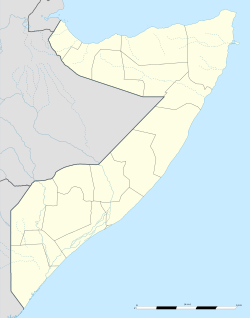Luuq
|
Luuq Ganaane |
|
|---|---|
| Town | |
| Location in Somalia | |
| Coordinates: 3°41′53″N 42°35′50″E / 3.69806°N 42.59722°ECoordinates: 3°41′53″N 42°35′50″E / 3.69806°N 42.59722°E | |
| Country | |
| Region | Gedo |
| District | Luuq |
| Population | |
| • Total | 41,000 |
| Time zone | EAT (UTC+3) |
Luuq (Somali: Luuq, Arabic: لوق) is a town in the southwestern Gedo province of Somalia. It is one of the older settlements in the area, Mareehan clan are the ones who inhabitants.is the seat of the Luuq District. The town is located in a bend of the Juba River, where the watercourse flows down from north to south in a horseshoe shape. Luuq is also known as Luuq Ganaane.
The name Luuq in the Somali language means "alley" by virtue of the city's geographical setting. The river has great influence on the city and its surrounding areas. The entrance of the city gate is situated not more than 100 meters from the river banks on both the eastern and western sides of the town. About 4 km past the city center and main Luuq Market, the river encloses the city again completely. Only the extreme southern side of the city has open land free from the river's enclosures.
Historically, Luuq is one of the oldest settlements in Somalia. In his 1811 report to the authorities of British India, captain Thomas Smee wrote Luuq had 300 huts, in comparison to Mogadishu which at the time had between 100 and 150 stone houses. Beginning in 1893, Luuq was attacked by Ethiopian raiding parties travelling down the Juba only when the Italian explorers Vittorio Bottego and Ugo Ferrandi arrived in 1895 were the Ethiopian attacks successfully repelled. Luuq came under indirect Italian control by 1907, and Italian interest in the town was serious enough for them to demarcate the only segment of the Somali-Ethiopian boundary in order to include Luuq as part of Italian Somaliland. For decades, it was the political center of the Gedo region.
...
Wikipedia

